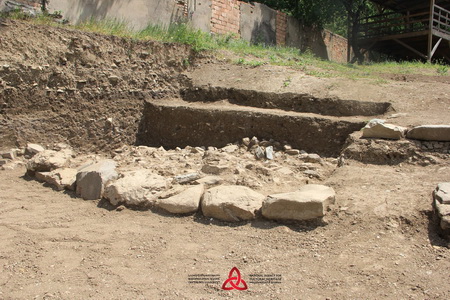New finding to launch fresh work at a central Georgia’s archaeological site

An unexpected discovery near the central Georgian city of Mtskheta is expected to kick-off fresh archaeological work at the site of the capital of the ancient Kartli Kingdom.
Wall constructions dating back to the 5th to 4th century BC were unearthed last week by archaeologists working in Armaziskhevi, a district of the city located 20km north of the capital, Tbilisi.
Experts working at the location said the wall section featured "influences” of the Achaemenid Empire, recognised as the First Persian Empire and dating back to c550–330 BC.

The new finding was made as seasonal work was winding down at the site. Photo: Georgia's Cultural Heritage Agency press office.
Georgian National Museum scientist Goderdzi Narimanishvili called the discovery "the first case” of remains of the time period being discovered in the area of the ancient Mtskheta, which served as the capital of the Kartli Kingdom.
Archaeologists chanced upon the finding as a seasonal archaeological work by the National Agency for Cultural Heritage Preservation of Georgia was winding down and expected to be the last in the area.
Now works are expected to be renewed on the location next year to study the new discovery.
The ancient Armaziskhevi district is known as the place of residence for the high-ranking court officials serving as provincial governors in the 3rd to 6th century AD Kartli Kingdom.

The location features remains of varying designation covering different time periods. Photo: Georgia's Cultural Heritage Agency press office.
Also working in the position in Persia’s later Sasanian Empire and ancient Armenia, the cast of the governors was known in Persian as bitaxs and in Georgian as pitiakhsh.
They are mentioned in ancient writings including Martyrdom of Shushanik, the earliest surviving work of the Georgian literature, dated between 476-483 AD.
Experts came across the new wall section while carrying out archaeological digs within a project for restoring the Armaziskhevi residence of the governors for visitors.
Archaeologists first carried out works at the site in the 1930s, with the current work by the cultural heritage agency ongoing since 2014.

The new findings will be subject of further archaeological work next year. Photo: Georgia's Cultural Heritage Agency press office.
Previous works revealed sections of a governor's palace dated back 2nd to 3rd century AD in addition to earlier remains from a 5th to 4th century BC settlement.
Historians have also detailed remains of a later residential complex at the location, dated 9th to 12th century AD.
Other constructions and buildings in the area include remains of a 2nd to 9th century AD burial site, baths, wine cellar and qvevri vessels for storing wine.
Digs carried out since 1937 excavated 144 individual graves, while works on graves of noble families unearthed Roman gold coins and various items manufactured in gold.
 Tweet
Tweet  Share
Share